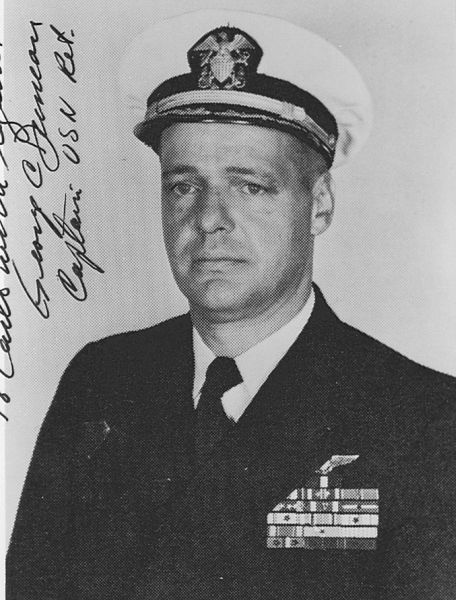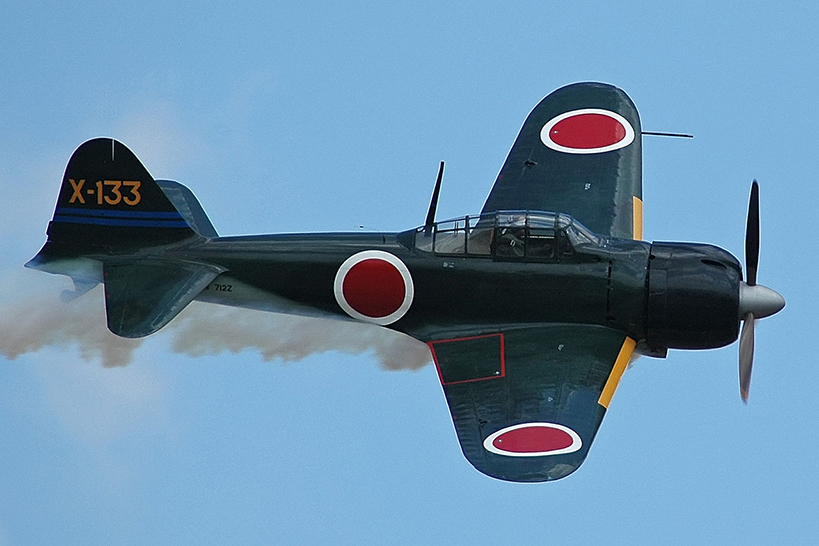Duncan, George Chamberlain
- Date of birth:
- February 11th, 1917 (Tacoma/Washington, United States)
- Date of death:
- December 15th, 1995 (Arlington/Virginia, United States)
- Nationality:
- American
Biography
Service number O-82484, United States Navy
George Chamberlain Duncan was born February 11th, 1917 in Tacoma, Washington. In June 1939 he graduated from the US Naval Academy in Annapolis. He initially served aboard U.S.S. West Virginia (BB-48).
At the outbreak of World War 2, Duncan was admitted to flight training at Pensacola. September 1943 saw him placed in Fighting Squadron 15 (VT-15) aboard the U.S.S. Essex (CV-9), flying the Grumman F6F Hellcat. June 15th, 1944 he downed his firt hostile aircraft, a Zero over Iwo Jima. At the end he completed 54 operational sorties and was ultimately credited with 13.5 victories. He attained ace-status on September 12th, 1944.
After WW 2, he served on the Staff of ComNavAirPac, as Commanding Officer Fighting Squadron 51 (VF-51) and of Fighting Squadron 101 (VF-101), as Commanding Officer CVG-5, Head Fighter Aircraft Design Branch BuAir, Assitent Director Aircraft Division at BuWeps, as Executive Officer of the U.S.S. Forrestal (CVA-59) and as Commanding Officer U.S.S. Ranger (CVA-61). He passed away in Arlington on December 15th, 1995.
After WW 2, George Duncan was awaded, among others, a Bronze Star with V for Valor; a Bar to the DFC (June 15th, 1953) and the Legion of Merit (November 4th, 1966).
Career:
May 7th, 1962 - May 20th, 1963: Commanding Officer U.S.S. Ranger (CVA-61).
Do you have more information about this person? Inform us!
- Period:
- Second World War (1939-1945)
- Rank:
- Lieutenant Commander
- Unit:
- Fighting Squadron 15 (VF-15), U.S.S. Essex (CV-9) (Fighting Squadron 15 (VF-15), U.S.S. Essex (CV-9))
- Awarded on:
- October 18th, 1944
"For conspicuous gallantry and intrepidity as a Fighter Pilot in Fighting Squadron FIFTEEN (VF-15), attached to the U.S.S. ESSEX (CV-9), in action against enemy Japanese forces in the central Philippines, on 13 September 1944. Alert and aggressive while leading his division in a hazardous fighter sweep against the enemy, Lieutenant Commander Duncan courageously intercepted a group of hostile planes and, pressing home his assaults with grim determination, personally shot down one medium enemy bomber and rendered invaluable assistance to a fellow pilot in destroying another during this engagement. Subsequently attacked by a vastly superior force of Japanese fighters, he skillfully maneuvered his plane for maximum striking power and, despite the tremendous odds, succeeded in blasting two of the hostile craft from the sky and in damaging a third. In addition, although opposed by concentrated anti-aircraft fire, Lieutenant Commander Duncan launched repeated hazardous strafing runs against grounded enemy aircraft, setting fire to and destroying three grounded planes. By his inspiring leadership, resolute courage and unwavering devotion to duty throughout, Lieutenant Commander Duncan contributed materially to the success of his squadron and upheld the highest traditions of the United States Naval Service."
Commander 1st Carrier Task Force Pacific: Serial 0659 (October 18, 1944).
- Period:
- Second World War (1939-1945)
- Rank:
- Lieutenant Commander
- Unit:
- Fighting Squadron 15 (VF-15), U.S.S. Essex (CV-9) (Fighting Squadron 15 (VF-15), U.S.S. Essex (CV-9))
- Awarded on:
- December 16th, 1944
"For extraordinary heroism in operations against the enemy while serving as Pilot of a carrier-based Navy Fighter Plane in Fighting Squadron FIFTEEN (VF-15), attached to the U.S.S. ESSEX (CV-9), in action against enemy Japanese surface forces over the Sibuyan Sea during the Battle for Leyte Gulf in the Philippine Islands on 25 October 1944. Undaunted by hostile anti-aircraft fire, Lieutenant Commander Duncan carried out an attack against major units of the Japanese Fleet, scoring a direct bomb hit to assist in sinking an enemy carrier, and contributing to the success of the mission. By his skill as an airman and devotion to duty throughout, Lieutenant Commander Duncan upheld the highest traditions of the United States Naval Service."
Commander 2d Carrier Task Force Pacific: Serial 0429 (December 16, 1944).
- Period:
- Second World War (1939-1945)
- Rank:
- Lieutenant Commander
- Unit:
- Fighting Squadron 15 (VF-15), U.S.S. Essex (CV-9) (Fighting Squadron 15 (VF-15), U.S.S. Essex (CV-9))
- Awarded on:
- August 26th, 1947
"For heroism and extraordinary achievement in aerial flight as Pilot of a Fighter Plane in Fighting Squadron FIFTEEN (VF-15), attached to the U.S.S. ESSEX (CV-9), in action against enemy Japanese forces in the Pacific War Area, on 6 November 1944. Skillfully fighting his plane, Lieutenant Commander Duncan engaged and shot down his fifth enemy aircraft on this date. His courage and devotion to duty were in keeping with the highest traditions of the United States Naval Service."
Commander Air Forces Pacific: Serial 6613 (August 26, 1947).
Sources
- Photo 1: Bill Gonyo
- - Sterner C.D., Recipients of The Navy Cross, 1916 - Present
- Home of Heroes
- Military Times Hall of Valor






